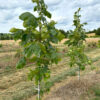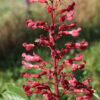For our April 2023 featured native, we’ve chosen a native April bloomer, the white fringetree, Chionanthus virginicus. Fringetree in the wild is an inhabitant of the savannas and moist ravines of the southeast piedmont and coastal plain from New Jersey south and west to northern Florida and east Texas and southern Arkansas. Chionanthus virginicus is the type specimen for the genus, from Greek chion ‘snow’ and anthos ‘flower’.
Typically white fringetree is a slow-growing large shrub or small tree, usually maturing at 18-25 ft / 5-8 m (occasionally 30+ ft / 10 m) in height, with an equal or slightly larger spread. It is a relatively slow grower; typically 6-12 inches /15-30 cm per year. The habit generally is bushy and multi-stemmed. The long, dark-green, glossy oval to lanceolate leaves emerge with the flowers in mid-spring, about the time the native dogwood (Cornus florida) flowers fade. The lightly fragrant, pure white flowers, with thin thread-like petals (hence the common name), are borne in dense drooping panicles that contrast well with the emerging foliage. Male and female flowers are usually borne on separate individuals. Like privet (Ligustrum), lilac (Syringa), and ash (Fraxinus), Chionanthus is a member of the olive family (Oleaceae). The flowers on female trees are followed by clusters of deep blue to purple olive-like fruits, usually containing a single seed. Fall color is a reliable bright golden-yellow.
[Article continues below photos.]
In the landscape, white fringetree makes an excellent specimen or focal point. Aside from the flowers, foliage, and fruit, additional seasonal interest comes from the light-green new twigs, which ripen to orange or light brown. The mature bark is brown with hints of dark red and somewhat scaly. Due to its smaller size, Chionanthus virginicus is ideal for suburban yards and is an excellent street tree; keeping lower than power lines and being very resistant to salt and pollution damage. It dislikes dry conditions, being happiest in moist, somewhat acidic soil, in sun or partial shade. It has few pests, typically only scale or mites in dry weather, but has been observed as a host for emerald ash borer (Agrilus planipennis). Unlike its sister trees in Fraxinus, the borer usually causes recoverable damage rather than fatality. The colorful fruits are a very attractive autumn food source for many native birds.
In short, Chionanthus virginicus is an attractive native for many landscape situations. For the fall 2023 digging season, White House Natives anticipates having multistem white fringetrees available in sizes from 4 to 6 feet. Keep an eye out for our availability updates as we move into late summer!







